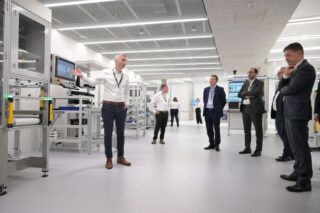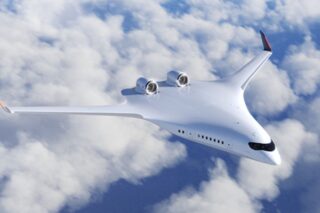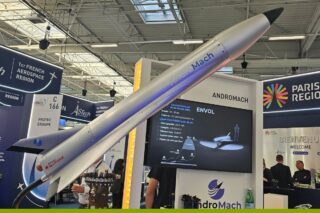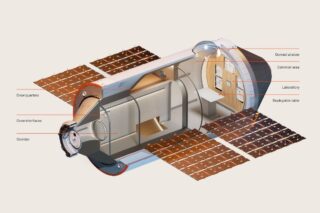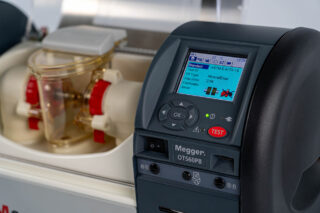Founded in June 2023, the French company Rob’Occ is emerging as an innovative force in the field of logistics with Roc-E, its AMR. This company, located in Occitania in the Tarn region, stands out for the design and development of its robots entirely Made in France, with 84% of components sourced in Europe.
The Roc-E, a Multifunctional AMR
Rob’Occ has developed an AMR to transport various loads in crates, whether it’s products for commerce or tools and raw materials in industry.
Initially, the AMR consists of a mobile base that can be sold to integrators so they can develop customized solutions for their clients. However, Rob’Occ has also developed Roc-E, a mobile base equipped with a shelf top capable of carrying crates with a capacity of 100 to 150 kilograms.
This innovative solution allows for the completion of repetitive and low-value tasks, thereby freeing up operators for more valuable tasks. The robot is capable of operating for a full day of production, or even two shifts without any issues. With battery autonomy in full navigation, it can operate for about ten hours.
Equipped with advanced navigation capabilities, the Roc-E can safely navigate complex environments without ever coming into contact with people. We saw it move around the wings of the Global Industrie trade show last month. It was indeed capable of moving autonomously. It would slow down and stop in front of an obstacle, such as a visitor crossing in front of it. And the same goes for when it encounters another AMR.
Its features include call buttons for transport requests, mission management, and a user-friendly interface for simplified operation.
According to Lucie Bouscarat, one of the 8 co-founders of Rob’Occ and in charge of communication,
“There are several functions: you can call it with call buttons placed on stations. If someone needs to send a tool for repair, he can put it in, send it to the repair workshop, and then Roc-E leaves. When it arrives, it signals that it’s here. The person takes what they need from it and sends it to another station via the Roc-E screen or releases it. And if Roc-E has nothing to do, it will go and charge itself in its charging area on a dock.”
Advantages and Specificities of Rob’Occ
Rob’Occ distinguishes itself with its ease of deployment. It requires no connection to the client company’s IT infrastructure, reducing costs and installation times. It can be deployed in less than an hour on a large site, as Lucie Bouscarat, explains:
“We first need to take it for a walk, it will do its rounds, look at everything around it, and make a map thanks to its geolocation sensors and cameras. It can map an area of 8000 m² in forty-five minutes. The map then appears on a fleet manager developed by our teams, accessible from a tablet fixed on Roc-E. We will then add in the app the red zones where Roc-E is not allowed to go, and the points of interest where it will need to go. Like all AMRs designed to work among operators, for the part of protecting people and dynamic obstacles, it will use cameras, ultrasonics, and lidar.”
For example, it is possible to instruct it to transport crates destined for assembly benches in a store aisle. The operator needs to specify the route, directing it through aisles A, B, C, and D. If there’s no one at A, it proceeds to B. Alternatively, the client can program it to follow a sequential path, from A to D. As long as no one has unloaded the crates, it remains stationary.
Simplified Programming
Roc-E has its own Wi-Fi, so it does not need to be connected to a company’s Wi-Fi. For Lucie, this enhances cybersecurity. The deployment process is also quick and does not require changes to infrastructure or production stoppages.
According to Brice Renaudeau, a Ph.D. in robotics and one of the 8 co-founders of Rob’Occ:
“The vehicle chooses its route based on the technology embedded in the vehicle. So there’s no need to install a server. This is also what makes Roc-E different from all the AMRs you’ve seen. It knows the map, and then its methods of calculation, artificial intelligence that can help it make the best decision.”
The off-grid fleet manager allows prioritization. For example, if maintenance calls, it needs to go there first. It is possible to retrieve data, see how many flows the robot has made, in how much time, and the points where it is frequently called.
“So, we can optimize, and know if more AMRs are needed in that area, and fewer in another area because it has been less frequently called. The advantage is that, for example, the shelf-top module, which simply attaches, can be used during the day to bring things. And then at the end of the day, another top can be clipped and the AMR is used to collect waste or chips from an industrial machine.”
The company trains its clients to be autonomous. If they need to make changes in their environment, they do not need to call for updates to the mapping. Pre-trained clients are capable of updating the mapping themselves simply through the fleet manager.
Maintenance
Similarly, for maintenance or in case of issues, an intelligent system will guide operators.
If there is a problem, for example, if the robot gets stuck or blocked, a photo of the blocked area appears on the tablet with an arrow indicating where to press to unblock it. The LED on the vehicle changes color at the spot where pressure is needed, Lucie details:
“We have really made it as simple as possible for customers. Everything is designed to make them independent. They also have control over maintenance. The most significant maintenance task will be cleaning the wheels occasionally depending on the environment in which they operate.”
AMR – AGV
While multiple AMRs can be deployed and are capable of avoiding each other, AMRs do not yet communicate with each other about the routes they intend to take to their loading/unloading points, as Brice explains:
“This approach requires centralizing information on a server somewhere. They know how to avoid each other, and in fact, we are perfectly capable of setting up traffic routes. So anyway, if they all travel in the same direction, they will never meet.”
Currently, Roc-E is a bidirectional AMR, capable of reversing. But it can also transform into an AGV, even though its primary function is to be as agile as possible.
“There are indeed large equipment manufacturers where there is security, a circulation center, and pedestrian crossings. And there, indeed, we can instruct it to only pass through that specific area, slightly to the right, not to exceed the boundaries, and only go in that direction. We can have navigation options that constrain it to behave in a certain way. I emphasize, these are free options!”
Affordable Solution
Indeed, pricing is a crucial consideration for the Rob’Occ team, which aimed to develop an affordable solution. Expect to pay just under €50,000 for the complete solution, including autonomous cart systems, call buttons, and batteries. The vehicle alone costs €35,000, while the recharge station is priced at €2,000. Lucie emphasizes:
“There are no hidden costs, unlike many competitors.”
Rob’Occ aims to make its technology accessible to a wide range of businesses, from small to large enterprises.
“Often, large groups have the infrastructure, but navigating IT is complex, and SMEs lack infrastructure and don’t have a million euros to spend on a comprehensive Wi-Fi network.”
They have already implemented the solution in large aerospace sites in Toulouse, as well as equipment manufacturers for component transportation. According to Lucie, it takes 18 to 24 months to install such a solution.
“And we have reduced the cycle to a maximum of two to four months.”
Future Outlook
Rob’Occ plans to develop larger models with a load capacity ranging from 500 kilograms to one ton. The company’s strategy also includes international expansion through manufacturing licenses, enabling the delivery of robots for assembly in other countries.
“We designed the robot to be sold abroad under license, and we deliver it for assembly. It’s in another country where they will assemble their vehicle, making exportation easier. In the medium term, the goal is to export and have factories capable of assembling Roc-E everywhere.”
The company has just completed a €1.4 million fundraising round and plans to expand from 12 employees to around thirty next year.






